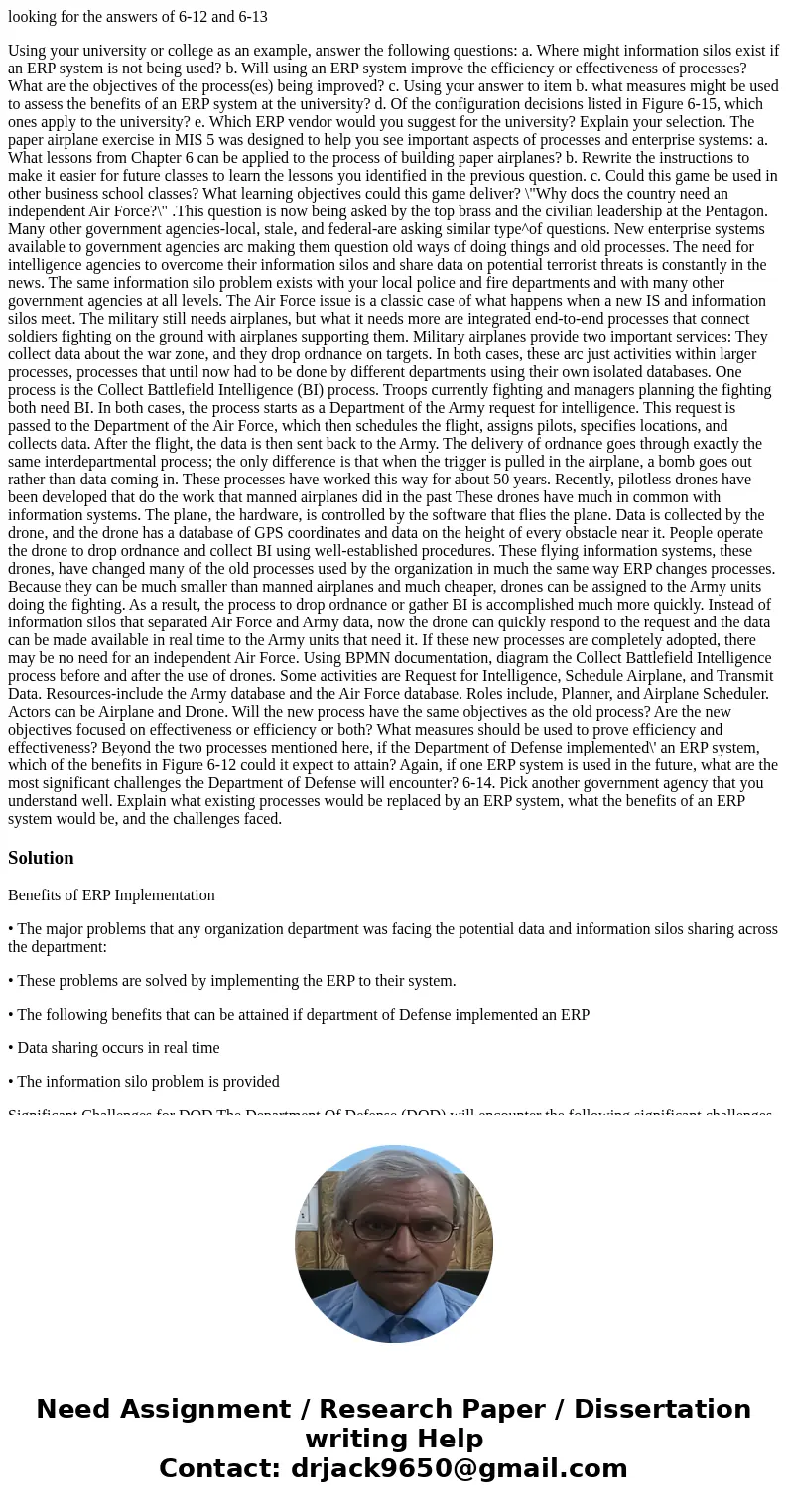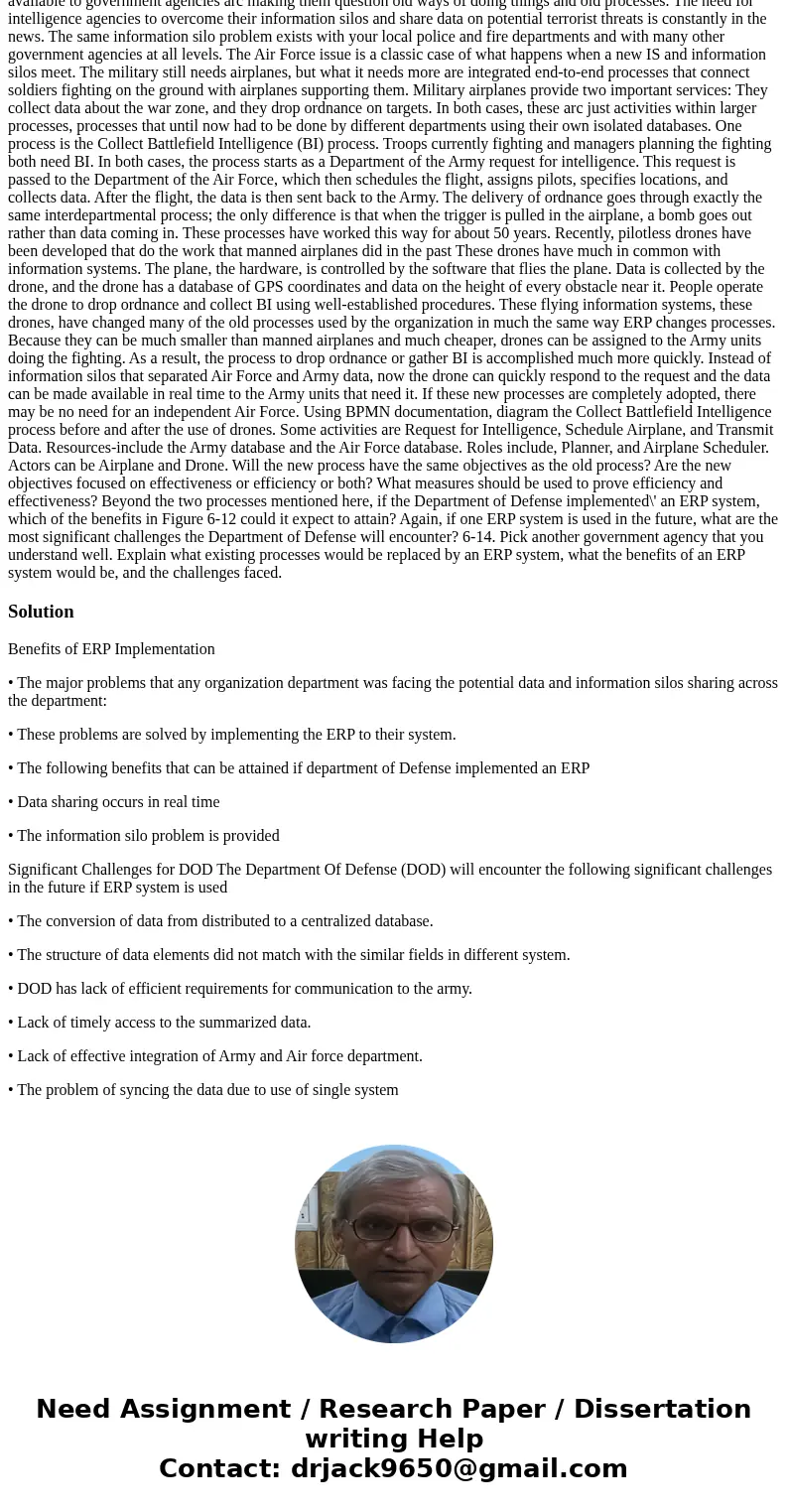looking for the answers of 612 and 613 Using your university
looking for the answers of 6-12 and 6-13
Using your university or college as an example, answer the following questions: a. Where might information silos exist if an ERP system is not being used? b. Will using an ERP system improve the efficiency or effectiveness of processes? What are the objectives of the process(es) being improved? c. Using your answer to item b. what measures might be used to assess the benefits of an ERP system at the university? d. Of the configuration decisions listed in Figure 6-15, which ones apply to the university? e. Which ERP vendor would you suggest for the university? Explain your selection. The paper airplane exercise in MIS 5 was designed to help you see important aspects of processes and enterprise systems: a. What lessons from Chapter 6 can be applied to the process of building paper airplanes? b. Rewrite the instructions to make it easier for future classes to learn the lessons you identified in the previous question. c. Could this game be used in other business school classes? What learning objectives could this game deliver? \"Why docs the country need an independent Air Force?\" .This question is now being asked by the top brass and the civilian leadership at the Pentagon. Many other government agencies-local, stale, and federal-are asking similar type^of questions. New enterprise systems available to government agencies arc making them question old ways of doing things and old processes. The need for intelligence agencies to overcome their information silos and share data on potential terrorist threats is constantly in the news. The same information silo problem exists with your local police and fire departments and with many other government agencies at all levels. The Air Force issue is a classic case of what happens when a new IS and information silos meet. The military still needs airplanes, but what it needs more are integrated end-to-end processes that connect soldiers fighting on the ground with airplanes supporting them. Military airplanes provide two important services: They collect data about the war zone, and they drop ordnance on targets. In both cases, these arc just activities within larger processes, processes that until now had to be done by different departments using their own isolated databases. One process is the Collect Battlefield Intelligence (BI) process. Troops currently fighting and managers planning the fighting both need BI. In both cases, the process starts as a Department of the Army request for intelligence. This request is passed to the Department of the Air Force, which then schedules the flight, assigns pilots, specifies locations, and collects data. After the flight, the data is then sent back to the Army. The delivery of ordnance goes through exactly the same interdepartmental process; the only difference is that when the trigger is pulled in the airplane, a bomb goes out rather than data coming in. These processes have worked this way for about 50 years. Recently, pilotless drones have been developed that do the work that manned airplanes did in the past These drones have much in common with information systems. The plane, the hardware, is controlled by the software that flies the plane. Data is collected by the drone, and the drone has a database of GPS coordinates and data on the height of every obstacle near it. People operate the drone to drop ordnance and collect BI using well-established procedures. These flying information systems, these drones, have changed many of the old processes used by the organization in much the same way ERP changes processes. Because they can be much smaller than manned airplanes and much cheaper, drones can be assigned to the Army units doing the fighting. As a result, the process to drop ordnance or gather BI is accomplished much more quickly. Instead of information silos that separated Air Force and Army data, now the drone can quickly respond to the request and the data can be made available in real time to the Army units that need it. If these new processes are completely adopted, there may be no need for an independent Air Force. Using BPMN documentation, diagram the Collect Battlefield Intelligence process before and after the use of drones. Some activities are Request for Intelligence, Schedule Airplane, and Transmit Data. Resources-include the Army database and the Air Force database. Roles include, Planner, and Airplane Scheduler. Actors can be Airplane and Drone. Will the new process have the same objectives as the old process? Are the new objectives focused on effectiveness or efficiency or both? What measures should be used to prove efficiency and effectiveness? Beyond the two processes mentioned here, if the Department of Defense implemented\' an ERP system, which of the benefits in Figure 6-12 could it expect to attain? Again, if one ERP system is used in the future, what are the most significant challenges the Department of Defense will encounter? 6-14. Pick another government agency that you understand well. Explain what existing processes would be replaced by an ERP system, what the benefits of an ERP system would be, and the challenges faced.Solution
Benefits of ERP Implementation
• The major problems that any organization department was facing the potential data and information silos sharing across the department:
• These problems are solved by implementing the ERP to their system.
• The following benefits that can be attained if department of Defense implemented an ERP
• Data sharing occurs in real time
• The information silo problem is provided
Significant Challenges for DOD The Department Of Defense (DOD) will encounter the following significant challenges in the future if ERP system is used
• The conversion of data from distributed to a centralized database.
• The structure of data elements did not match with the similar fields in different system.
• DOD has lack of efficient requirements for communication to the army.
• Lack of timely access to the summarized data.
• Lack of effective integration of Army and Air force department.
• The problem of syncing the data due to use of single system


 Homework Sourse
Homework Sourse